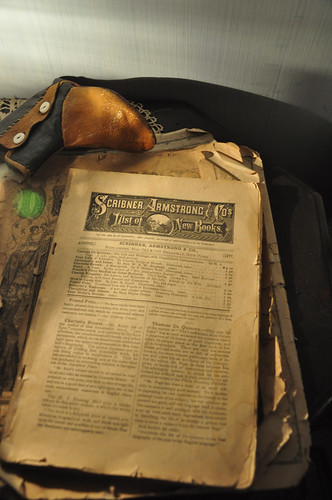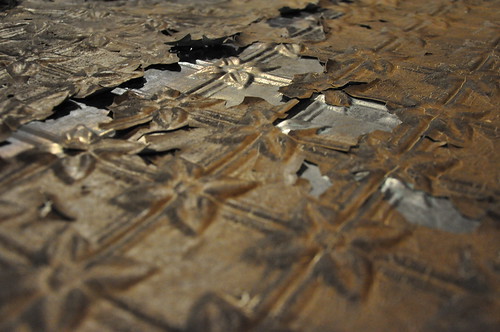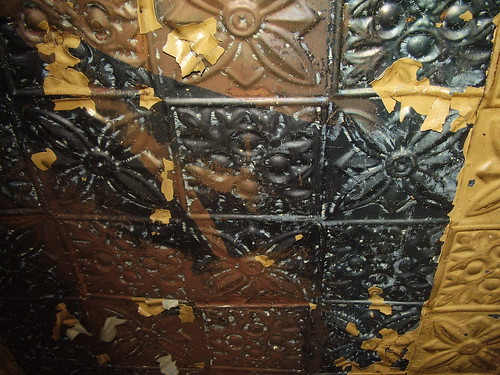Enter the apartments at 97 Orchard Street and you’ll see many objects crammed into these tiny spaces. Some, like toasters, lamps, and vacuums, served practical roles, while others, such as dumb bells and books, represent the interests of specific individuals.
Regardless of their uses, objects in these apartments are more than just furnishings; they can be used to tell stories about daily life in the tenement. With a Coney Island souvenir, we can talk about how immigrant families maintained the cultural traditions of their home country while adopting American customs. By highlighting wallpaper, tablecloths, and other decorative items, we can discuss how tenants made their apartments into homes.
A recent grant from the National Endowment for the Humanities (NEH) is allowing the Museum to rethink the way it uses objects to talk about 97 Orchard Street and the broader history of the Lower East Side.
To kick off the grant, educators explored the apartments and wrote their own “biographies” of objects – imagining what they meant to the people who used them. Below are some of our favorites:
Josephine’s Skippy Jar Lamp
 |
| Photo Credit: Keiki Niwa |
“Josephine had begged and pleaded and promised perfect behavior to Rosario. She only wanted one thing: to try peanut butter. Peanut butter made you American, made you strong, she reasoned. Rosario protested: too American, unnatural, expensive. But one week in October of 1931, the Home Relief Box contained a surprise – a jar of Skippy! It was the most delicious thing Josephine had ever tasted. She and Johnny ate one huge spoonful each the first day of the jar’s life in 97 Orchard, then carefully made it last until almost April of the next year. Not wanting to get rid of the jar, Josephine asked Rosario if she could use it.
Si! She had just been given a kerosene lamp top by a woman at work whose husband made them, but didn’t have anything to use it with. The jar then lit the families’ late night stories, after they’d turned the lights off. The jar got tossed with the move out of 97 though, too much a symbol of sticky times.”
 |
| (c) Tenement Museum |
Baldizzi’s School Books
“On the kitchen window sill sit books for Johnny and Josephine Baldizzi’s education. The proud parents bought them so their children would not have to use the books that were falling apart in the school. By buying the books, the parents could also have their children do homework and read at home. As Rosario bustles around the kitchen, Johnny and Josephine sit at the desk reading in between numerous distractions.
The primers and normal readers allow the children access to America. Here in the Baldizzi apartment, the school books show everyone the hopes and aspirations that Rosario and Adolfo have for their children. When the children finish, the parents may peruse the books, picking up useful words and phrases. It is a bittersweet moment, though, as they realize all their children will learn and know. The struggle of immigration becomes comprehensible and worthwhile in those fleeting moments – staring at the foreign words on the page.”
Fannie Rogarshevsky’s New Bissell’s Grand Rapid Vacuum
 |
Photo Credit: Keiki Niwa |
We imagine Fanny as an amazing housekeeper, but I think of her as a sap for new cleaning innovations. Each week, it’s a new purchase: powder/disinfectant, lino-wash.
"Oh no. The day this came home.
After repeated protestations to Abraham and family that they NEEDED a vacuum, that all of her friends had them (even though her son, Sam was the first to point out they didn’t have a rug), even though Ida said they had a Bissell’s at the factory and it was a piece of junk, the family finally caved.
It cost $65.
When it arrived, everyone crowded around it. Fanny had just cleaned, so there was nothing to vacuum up. “What are we going to do?” they all cried. A piece of bread was summoned. But it wasn’t stale enough. So they toasted it for a while so they could crumble it on the floor.
A pause.
A roll over the crumbs.
And the crumbs remain.
“It must have a switch wrong somewhere…” Hours disassembling and reassembling the Bissell. The crumbs remain. Finally, Fanny cleans them up with a wet rag, just as she always has done."
Rogarshevsky Family Toaster
 |
| Photo Credit: Keiki Niwa |
“Hanging on the wall above the stove in the Rogarshevsky apartment is a metal circle with holes in the bottom and four wire sides that connect to form a base. People often ask about this object, which I have imagined to be a toaster. I imagine that this wasn’t a very expensive item. It could probably be purchased in a 'hardware' store, some place that sold metal items. Perhaps it was something made locally and sold everywhere. It doesn’t seem important enough to bring from the home country.
Because it’s a rather small object, I don’t imagine the neighbors having much interest. Maybe one of the other women in this building suggested that Fannie should purchase a toaster. Maybe it was seen as a time saver. Maybe the same woman suggested which shop or peddler had the best price.
It’s not a special object. It’s not something to be passed on from one generation to the next. Perhaps for this family it meant that they were settling in to their new American lives and schedules.”
Natalie Gumpertz’s Clock
 |
| (c) Tenement Museum |
"Natalie was beside herself as she watched from the carriage her home fade into the distance. She had sold all her belongings in the past days and now had enough money for her journey to America.
In America, Natalie felt scared, but she was getting more accustomed to life here every day. Her neighbors all spoke German, although many didn’t speak her dialect. Mr. Glockner’s wife was Prussian and had a close friend, who introduced her to some young men, potential suitors, although she was staying with her cousin and didn’t have much room to herself. She enjoyed shopping and thinking about a home for herself.
She walked by William’s Clockworks that week and something caught her eye. It was a clock, a clock that reminded her of her grandmother’s home in Prussia. As the wave of nostalgia passed over her, she knew she had to buy it. She took out her small savings and went into the store.
For years Natalie had kept the clock inside her suitcase covered in cloth. But today was the day she would take it out. She and Julius had just married, and Mr. Glockner had an apartment in his building for them. Finally, a home."
What’s your favorite object from 97 Orchard Street? Share your own object biography with our readers.
-posted by Shana Weinberg









































